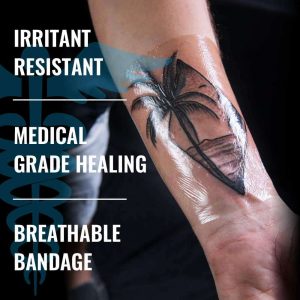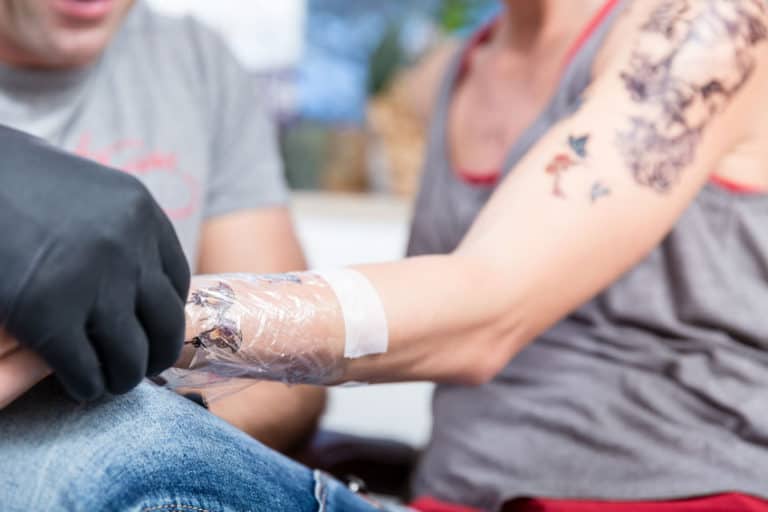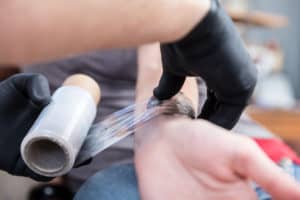Wrapping tattoos in plastic or saran wrap is a form of caring for a new tattoo known as wrap healing. It’s done to protect the tattoo while it’s healing, but it still allows the piece to be shown off.
The idea of wrapping tattoos in plastic came from bikers in the 70’s and 80’s. People were tired of lifting up bandages at biker gatherings to show off their new ink, so someone decided to wrap it in plastic, and a new trend was born.
Purpose of the Wrap
A tattoo is an open wound. If you had a cut or burn, you would want it protected. Tattoos are the same. Whether it’s covered with a bandage or plastic wrap, keeping the tattoo covered allows you to control what your tattoo gets exposed to, and helps keep out dirt and bacteria so that it can heal properly.
Saran wrap specifically is used because it allows you to see your tattoo and keep an eye on the healing process.
When you are getting a tattoo, the artist uses needle or needles to push ink under the surface of your skin, into the dermis.
By the time the tattoo is complete, you have a significant portion of your skin that has been repeatedly punctured by a needle. This creates a wound that’s similar to an abrasion.
It’s incredibly vulnerable to infections and other complications, which is why it’s important to take good care of it and give it the proper amount of time to heal.
Before you start wrapping your tattoo, you need to make sure that it’s clean. It’s important to wash it several times each day to keep it clean and free of dirt and bacteria.
Use a gentle antibacterial soap- hand soap works great, just make sure that it’s unscented. Wash gently with a washcloth and towel dry. After you wash your tattoo, you should moisturize it.
Use a basic, fragrance free moisturizer, like Lubiderm or Eucerin. Moisturizing helps prevent the tattoo from peeling and itching. (No matter how itchy your tattoo may get, don’t pick at it! You could cause scarring and damage the design.
There’s a ton of fancy tattoo aftercare products on the market, but generally it works just as well to stick with basic soap and moisturizer. You should wash and moisturize your tattoo before and after you wrap it. Even when you’re done wrapping your tattoo, keep washing and moisturizing until it’s no longer scabbing.
You may be tempted to apply rubbing alcohol, Vaseline, or antibiotic ointments like Neosporin to speed up the healing process. Don’t do this. Rubbing alcohol dries out the tattoo, while Vaseline and Neosporin can trap dust and dirt and potentially cause an infection.
Is It Okay To Saran Wrap A Tattoo?
Wrapping your tattoo is good in certain situations. When you leave the tattoo shop, it will definitely be wrapped or covered, whether with saran wrap or a bandage.
In most states, this is required by law for health reasons. But the important thing to remember is that tattoos need air to heal.
So there are times when it is appropriate to wrap your tattoo, but it shouldn’t be wrapped all the time. Saran wrap has problems of its own, however.
The nature of plastic is that it creates an airtight seal, and clings to the skin. This does not allow the tattoo to breathe and can lead to a buildup of ink and blood on the tattoo.
Additionally, it heats up the area, creating a breeding ground for bacteria. Saran wrap has the possibility to harm the tattoo and seriously disrupt the healing process. It should not be used to wrap a tattoo unless absolutely necessary, and even then, it should only be worn for short periods of time.
If you experience any symptoms of an infected tattoo, stop wrapping it and visit your tattoo artist or a doctor as soon as possible. Symptoms of an infected tattoo include a fever, swelling of the tattoo, lesions or pus, and muscle aches and pains.
If you’re ever unsure, it’s better to be safe than sorry- go see a doctor! You are more likely to experience issues with your tattoo’s healing process if you use saran wrap to cover it or don’t wash and moisturize it properly.
How Long Should You Wear A Wrap ?
Wraps in general should be worn for the first 3-5 days, but not all the time. Wrap your tattoo when you’re wearing tight clothing, will be participating in athletic activities, out in the sun or getting dirty, and when you’re sleeping. Otherwise, it’s best to keep a new tattoo free to breathe.
If at all possible, saran wrap should only be used if you don’t have sterile bandages available to cover your new tattoo. And it should not be used if you’re going out in the sun.
Make sure you keep the wrap clean and use a new bandage, or, if necessary, piece of saran wrap each time you wrap your tattoo. Try to keep your tattoo away from chlorine, salt water, and sun- these can cause it to fade, even if it’s wrapped.
Are There Alternatives?
Instead of saran wrap, it is much safer to just use sterile bandages to wrap your tattoo. It’s better for the environment, too! While it’s fun to show off your new tattoo to friends and family, it’s more important to make sure it heals properly so that there’s a nice tattoo to show people! Saran wrap is better than no wrap, but it ideally should not be used. Your tattoo will thank you!

Saniderm bandages are clear, so that you can still show off your ink, but they are made to allow the tattoo to breathe, so they are a much safer alternative to saran wrap.
They also eliminate the need for washing and moisturizing your tattoo 3 or more times each day.
Some tattoo shops provide them as part of getting inked. Ask your tattoo artist if they have them, or if they don’t, they’re available online and at drugstores.
They only need to be worn for 7-10 days and then your tattoo should be healed. Even if you do use a Saniderm bandage, it doesn’t hurt to keep moisturizing your tattoo after it’s healed. It helps prevent it from fading, and you can’t really over-moisturize.
The important thing to remember about wrapping and caring for your new tattoo is that you should do what’s right for you.
Everyone will have a different experience with the healing process. Sometimes it can even vary from tattoo to tattoo on the same person. If you’re more comfortable with using specially formulated ointments to care for your tattoo, go for it!
If you’d rather just stick to soap and lotion, that’s okay too! Discuss options with your tattoo artist and choose what you’re most comfortable with.
Your tattoo artist might have suggestions, too! Make sure that no matter what you choose, you take good care of your tattoo and give it proper time to heal. It’s worth it!


